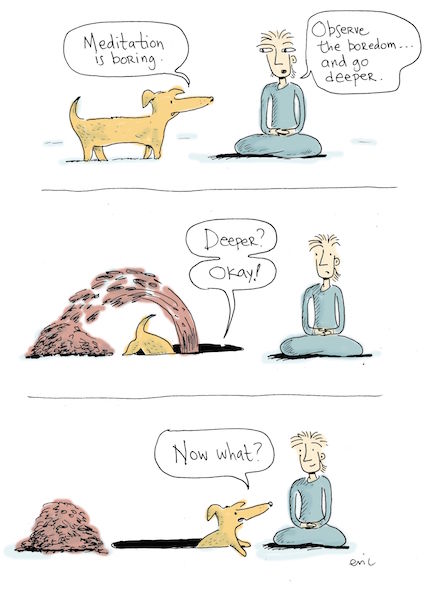A reader writes:
I’ve stopped and started meditation several times. While I’m sure I haven’t given it a fair trial, when I’ve done it I haven’t gotten anything out of it …unlike exercising, for example. After a 25-minute jog I feel better.
I don’t feel anything after a meditation session.
But I have stress and anxiety that I’d like to deal with better and meditation has great reviews when it comes to stress and anxiety. I’m willing to commit to 10 minutes/day and short deep breath breaks during the day but I can’t see going any further until I see at least a glimpse of benefit from it.
Thank you for writing.
You’d like to experience the benefits of meditation. (Me too!)
Given that we’re in the same boat, I have some good news and some bad news.
The good news is:
You can learn how to meditate and experience the benefits.
The bad news is:
You’re never done learning how to meditate.
The benefits will come—but not in the way you imagine.
The problem with the good news is that it sets you up for frustration.
You read about meditation and learn about all the amazing benefits. You listen to teachers and are inspired to practice. You want what they promise.You want the benefits.
Reading about meditation is like reading a menu.
As you read the menu, you create mental representations of the different items. You “taste” the food in your mind. When you read a description that generates a particularly tasty mental experience, you stop and say, “That sounds good. I’ll have that!”
Then the meal arrives.
No matter what you’ve imagined, the actual meal isn’t what you thought it would be. It’s not a thought; it’s what’s on your plate. It’s the meal you’re chewing on, tasting and swallowing.
You may be disappointed or you may ecstatic.
Either way, you’re experiencing something that is more primary than your initial ideas about the meal.
Your ideas are secondary representations of the meal. They’re not the meal; they got you to order the meal. Now you’re chewing on the real thing.
It’s the same with meditation.
Reading books and listening to teachings generates mental representations of what meditation could be like. When you read a text or hear a teaching that generates a particularly pleasant mental experience, you stop and say, “That sounds good. I’ll have that!”
You start practicing.
You’d never start if you didn’t have an idea about the benefits.
So the reading, the listening, and the idea generating are useful. They provide initial motivation. They get you started. Teachings provide you with mental representations of what you want meditation to feel like and do for you.
Ideas get you to sit down.
That’s when the contrast between your ideas of how you want it to be and the way it is arises.
Because no matter how carefully you’ve constructed your mental representation, it will never match the actual experience of this moment. This moment is what it is…regardless of your ideas and expectations.
This is true at restaurants and on the meditation cushion.
As you practice, this contrast becomes more and more obvious. Your practice is not your idea of practice.
How you meet this contrast is learning how to meditate.
How you meet this contrast is what will bring you benefits that you cannot imagine.
Notice the word—how.
This word—how—is the key to embracing the bad news about meditation.
Remember the bad news?
You’re never done learning how to meditate.
The benefits will come—but not in the way you imagine.
Any and all ideas about what meditation is or can be are seen for what they are—thoughts. Thoughts aren’t wrong or bad. So, what are they?
Thoughts are secondary.
These secondary mental constructions are useful as they motivate us to practice. They bring you to the cushion, but then it’s time turn from the mind’s fascination with secondary phenomenon to that which is primary.
What is primary?
The direct experience of this moment is primary.
While thoughts about benefits may bring you to the cushion, holding on to those thoughts will drive you away. Thoughts about peace of mind, awakening and freedom can bring you to the practice. But thinking about peace won’t sustain practice. This isn’t a condemnation of thought.
It’s just a realization of the limits of thought.
Comparing your experience of this moment to your expectations and hopes will always end in disappointment. Sooner or later. That’s guaranteed.
Still, you don’t have to push thoughts away (that only entangles you more and more).
Honor thought for what it can do.
Once you’re on the cushion, thought has fulfilled its purpose. Now it’s time let go of assessing, measuring and evaluating whether or not you’re getting what you thought you wanted. It’s time to open up to what is primary—the full and radiant experience of this moment.
Opening up is a practice.
You don’t push thoughts about meditation away. Where could they go, anyway?
Instead, you look deeply and gratefully—see thoughts have fulfilled their purpose. When you see this, your attention naturally shifts towards that which is primary.
And then, with a breath, thoughts dissolve.
As they do, a new vista emerges. A new awareness of the meaning and benefit of meditation…and you smile. Because what you experience, in this moment, is something you couldn’t have imagined.
Relephant:
The Simple Technique that Changed My Life.
~
Author: Eric Klein
Editor: Travis May
Photo: Flickr/Hartwig HKD







Read 2 comments and reply